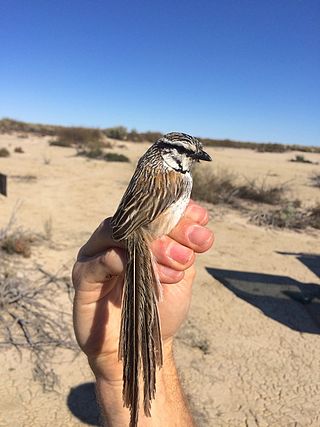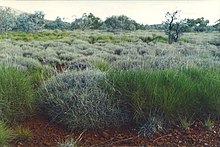
Astrebla Downs is a national park in Shire of Diamantina, Queensland, Australia.

Diamantina National Park is a national park in the Channel Country of South West Queensland, Australia, 1,278 km (794 mi) west of Brisbane. Like the Diamantina River that flows through it, it is named for Lady Diamantina Bowen, wife of Sir George Bowen, the first Governor of Queensland.

Platycercinae is a subfamily of birds belonging to the family Psittaculidae that inhabit Oceania. It consists of two tribes, the ground parrots and allies (Pezoporini) and the many species of broad-tailed parrot (Platycercini).

The bridled nail-tail wallaby, also known as the bridled nail-tailed wallaby, bridled nailtail wallaby, bridled wallaby, merrin, and flashjack, is a vulnerable species of macropod. It is a small wallaby found in three isolated areas in Queensland, Australia, and whose population is declining. In early 2019 the total population of the species was estimated to be fewer than 500 mature individuals in the wild and 2285 in captivity.

The orange-bellied parrot is a small parrot endemic to southern Australia, and one of only three species of parrot that migrate. It was described by John Latham in 1790. A small parrot around 20 cm (8 in) long, it exhibits sexual dimorphism. The adult male is distinguished by its bright grass-green upper parts, yellow underparts and orange belly patch. The adult female and juvenile are duller green in colour. All birds have a prominent two-toned blue frontal band and blue outer wing feathers.

Bourke's parrot, also known as the blue-vented parrot, sundown parrot, pink-bellied parrot, Bourke's parakeet, Bourke or "Bourkie", is a small parrot found in Australia and the only species in its genus, Neopsephotus. It is approximately 19 cm long and weighs around 45 grams. It is named after General Sir Richard Bourke, Governor of New South Wales from 1831 to 1837.

The red-tailed black cockatoo also known as Banksian- or Banks' black cockatoo, is a large black cockatoo native to Australia. Adult males have a characteristic pair of bright red panels on the tail that gives the species its name. It is more common in the drier parts of the continent. Five subspecies are recognised, differing chiefly in beak size. Although the more northerly subspecies are widespread, the two southern subspecies, the forest red-tailed black cockatoo and the south-eastern red-tailed black cockatoo are under threat.

Threatened fauna of Australia are those species and subspecies of birds, fish, frogs, insects, mammals, molluscs, crustaceans, and reptiles to be found in Australia that are in danger of becoming extinct. This article lists species classified as threatened species under the Commonwealth Environment Protection and Biodiversity Conservation Act 1999.
The Austin expedition of 1854 was an expedition of exploration undertaken in Western Australia by Robert Austin in 1854. Members of Austin's party comprised John Hardey, Kenneth Brown, James Tatton Brockman Fraser (artist), Thomas Whitfield, James Guerin, Richard Buck, J. Edwards, W. Cant, Charles Farmer, and J. Woodward; and aboriginals Narryer, Wambinning, Wooddang and Souper.

The swift parrot is a species of broad-tailed parrot, found only in southeastern Australia. The species breeds in Tasmania during the summer and migrates north to south eastern mainland Australia from Griffith-Warialda in New South Wales and west to Adelaide in the winter. It is a nomadic migrant, and it settles in an area only when there is food available. The Swift Parrot was voted 2023 Bird of the Year in The Guardian Australia and BirdLife Australia’s biennial poll.

The genus Pezoporus contains two Australian species: the night parrot and the ground parrot The night parrot was previously separated in a distinct genus, Geopsittacus. The genus is part of the tribe Pezoporini.

The ground parrot of Australia is one of only four ground-dwelling parrots in the world, the others being its closest relatives, the extremely rare night parrot, the somewhat closely related Antipodes parakeet, and the unrelated highly endangered kakapo from New Zealand.

The blue-winged parrot, also known as the blue-banded parakeet or blue-banded grass-parakeet, is a small parrot found in Tasmania and southeast mainland Australia. It is partly migratory, with populations of blue-winged parrots travelling to Tasmania for the summer. The parrot is sexually dimorphic – the males have more blue on the wings and a two-toned blue frontal band on the head, while females are duller and have more green on the wings and a wingbar. Both sexes have predominantly olive-green plumage. Predominantly a feeder on the ground, the blue-winged parrot mainly eats seeds of grasses. It adapts readily to captivity.

The grey grasswren is a passerine bird in the Australasian wren family, Maluridae. It is found on arid inland floodplains of Australia where it is endemic. The grey grasswren is a rarely seen elusive bird that was first sighted in 1921 but not taxonomically described until 1968. Its greyish coloration and very long tail distinguish it from all other grasswrens. While some recent research has been conducted, there still remain many gaps in the knowledge about the ecology of this cryptic bird.
Pungalina-Seven Emu Sanctuary is a 3060 km2 private protected area in the Northern Territory of Australia. It is managed by the Australian Wildlife Conservancy (AWC) which purchased Pungalina Station in 2009, with some assistance from the Wildlife Australia Fund. It adjoins the Gulf of Carpentaria near the border with Queensland, lying in the Gulf Coastal bioregion. The reserve is bordered by Calvert Hills and Wollogorang Stations to the south and east. The nearest town is Borroloola, 150 km to the west.

Bowra Sanctuary is a 140 km2 nature reserve near Cunnamulla in South West Queensland, Australia. It lies in the Mulga Lands bioregion on the Warrego River plains, in the catchment of the Warrego and Paroo Rivers. It is owned and managed by the Australian Wildlife Conservancy (AWC).

The Cloudbreak mine is an iron ore mine located in the Pilbara region of Western Australia, 89 kilometres west-south-west of Nullagine, in the Chichester Range.
The blue-browed fig parrot, also referred to as the blue-fronted fig parrot, is a putative undescribed fig parrot said to inhabit the rugged rainforest-covered border ranges of subtropical south-eastern Queensland and north-eastern New South Wales, Australia. It was announced in November 2006 as the discovery of a new species or subspecies. However, the existence of the parrot has not been confirmed and the claimed discovery has been questioned.

Frederick Bulstrode Lawson Whitlock (1860-1953) was an ornithological writer and oölogist, active in England and across Western Australia.
John Young is an Australian naturalist and cinematographer.



















